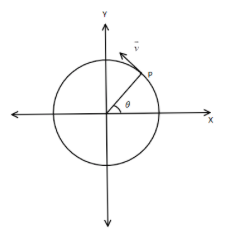
Calculate the angular and linear speed of the 2nd hand of the clock of length \[7cm\] .
Answer
476.7k+ views
Hint:
We all know the clock has 3 hands. The hour hand, the minute hand and the second hand. The minute hand is the 2nd hand which takes 1 hour to complete its one circle of rotation. Similarly the hour hand and second hand take 12 hours and 1 minute to complete one rotation.
Complete step by step answer:
We know that in circular motion, angular speed or velocity is a completely different physical quantity than angular speed.
Let’s look at the following diagram.

A particle in motion P, has an angular displacement of $\theta $ for a time period of complete rotation $t$ .
Angular velocity is defined as rate of change of angular positions $\theta $ , that is $\omega = \dfrac{{d\theta }}{{dt}}$
Where $d\theta $ and $dt$ are the changes in angular displacement and time respectively.
The unit of angular velocity is $rad{s^{ - 1}}$
The linear velocity of the particle P is displacement per unit time or $v = \dfrac{{ds}}{{dt}}$
Where $ds$ is the change in position/displacement of the particle.
Linear velocity is related to angular velocity by the following equation,
$v = r\omega $ , where $r$ is the radius of the circular trajectory the particle exhibits.
As the second hand of the clock, that is, the minute hand takes 1 hour to complete a full rotation ( a full rotation means angular displacement of $2\pi rad$ .
Thus the angular velocity will be, $\omega = \dfrac{{2\pi }}{{3600}}$
Because 1 hour converted to seconds is $3600s$
$ \Rightarrow \omega = 5.48 \times {10^{ - 3}}rad.{s^{ - 1}}$
Now, the linear velocity of the 2nd hand of the clock will be,
$v = r\omega $
Given that the length of the 2nd hand is $7cm$ or $0.07m$. Substituting the values of $\omega $ and $r$ we get,
$v = 0.07 \times 5.48 \times {10^{ - 3}}$
$ \Rightarrow v = 3.8 \times {10^{ - 4}}m{s^{ - 1}}$
This is the value of linear velocity of the tip of the 2nd hand of the clock.
Note: Make sure you are doing calculations in the same system of units. While converting use power of 10 values for easier calculations. We can similarly calculate the angular and linear velocities of 1st and 3rd hands of a clock such that their time period for a complete rotation around the clock is 12 hours and 1 minute respectively.
We all know the clock has 3 hands. The hour hand, the minute hand and the second hand. The minute hand is the 2nd hand which takes 1 hour to complete its one circle of rotation. Similarly the hour hand and second hand take 12 hours and 1 minute to complete one rotation.
Complete step by step answer:
We know that in circular motion, angular speed or velocity is a completely different physical quantity than angular speed.
Let’s look at the following diagram.

A particle in motion P, has an angular displacement of $\theta $ for a time period of complete rotation $t$ .
Angular velocity is defined as rate of change of angular positions $\theta $ , that is $\omega = \dfrac{{d\theta }}{{dt}}$
Where $d\theta $ and $dt$ are the changes in angular displacement and time respectively.
The unit of angular velocity is $rad{s^{ - 1}}$
The linear velocity of the particle P is displacement per unit time or $v = \dfrac{{ds}}{{dt}}$
Where $ds$ is the change in position/displacement of the particle.
Linear velocity is related to angular velocity by the following equation,
$v = r\omega $ , where $r$ is the radius of the circular trajectory the particle exhibits.
As the second hand of the clock, that is, the minute hand takes 1 hour to complete a full rotation ( a full rotation means angular displacement of $2\pi rad$ .
Thus the angular velocity will be, $\omega = \dfrac{{2\pi }}{{3600}}$
Because 1 hour converted to seconds is $3600s$
$ \Rightarrow \omega = 5.48 \times {10^{ - 3}}rad.{s^{ - 1}}$
Now, the linear velocity of the 2nd hand of the clock will be,
$v = r\omega $
Given that the length of the 2nd hand is $7cm$ or $0.07m$. Substituting the values of $\omega $ and $r$ we get,
$v = 0.07 \times 5.48 \times {10^{ - 3}}$
$ \Rightarrow v = 3.8 \times {10^{ - 4}}m{s^{ - 1}}$
This is the value of linear velocity of the tip of the 2nd hand of the clock.
Note: Make sure you are doing calculations in the same system of units. While converting use power of 10 values for easier calculations. We can similarly calculate the angular and linear velocities of 1st and 3rd hands of a clock such that their time period for a complete rotation around the clock is 12 hours and 1 minute respectively.
Recently Updated Pages
Master Class 12 Economics: Engaging Questions & Answers for Success

Master Class 12 Maths: Engaging Questions & Answers for Success

Master Class 12 Biology: Engaging Questions & Answers for Success

Master Class 12 Physics: Engaging Questions & Answers for Success

Master Class 12 Business Studies: Engaging Questions & Answers for Success

Master Class 12 English: Engaging Questions & Answers for Success

Trending doubts
Draw a labelled sketch of the human eye class 12 physics CBSE

Differentiate between homogeneous and heterogeneous class 12 chemistry CBSE

What are the major means of transport Explain each class 12 social science CBSE

Which of the following properties of a proton can change class 12 physics CBSE

What is a transformer Explain the principle construction class 12 physics CBSE

Why is the cell called the structural and functional class 12 biology CBSE




